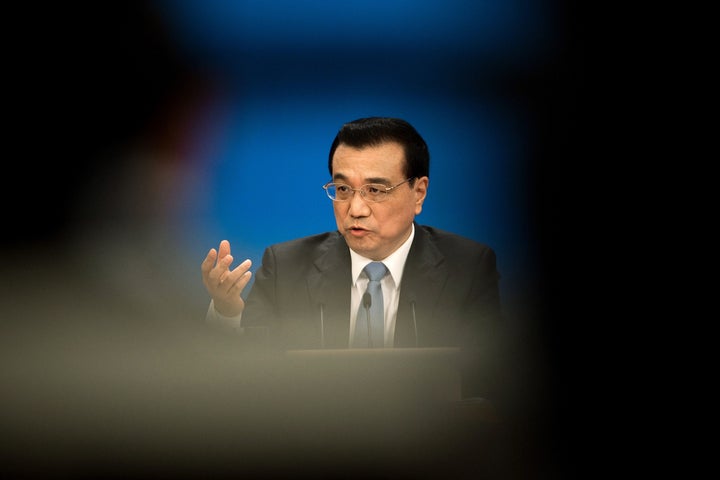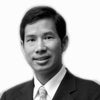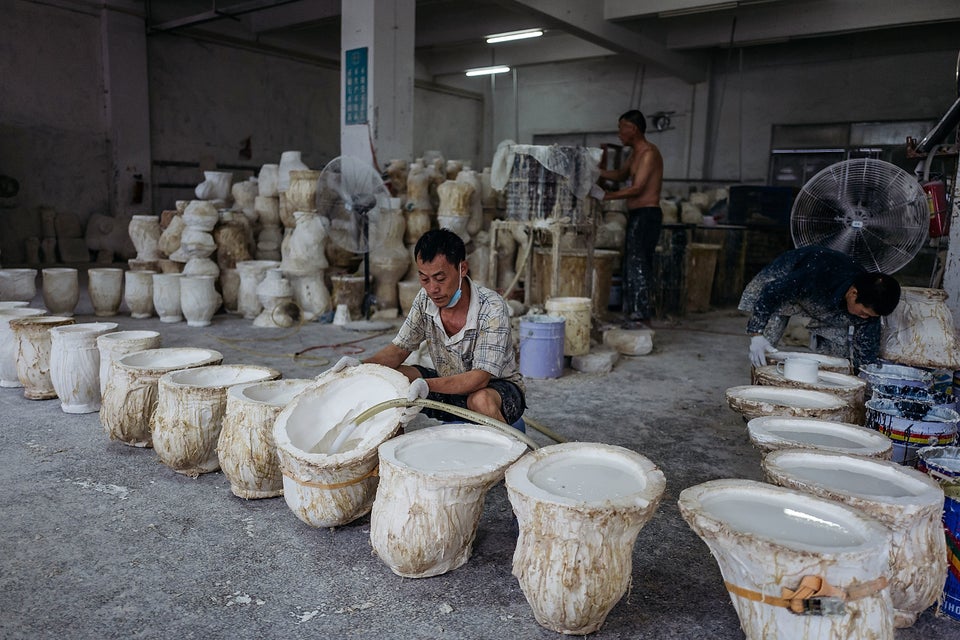
BEIJING ― No earth-shattering bold initiatives, no drastic policy U-turns and no fundamental changes emanated from the recent annual gathering of China’s National People’s Congress, the national forum to unveil major economic and social policies for the current year.
Instead, amid the shock unleashed by the Donald Trump administration in the U.S., Brexit and unpredictable upcoming European elections ― plus, of course, a host of domestic challenges, such as debt, industrial overcapacity and mounting environmental problems ― the keywords underlining China’s economic program for 2017 seem to be three C’s: caution, consistency and continuity.
First and foremost, Premier Li Keqiang, in his 2017 Government Work Report, China’s equivalent of a State of the Union address, set the country’s official GDP growth target for 2017 at “around” 6.5 percent, compared with a slightly higher range last year. The lower figure is in line with the recent trend of gradually lowering growth expectations as the Chinese economy matures and the public’s interest shifts to tangible improvements in the standard of living, including higher-paying jobs, food safety, air quality and pension benefits.
China’s lower growth target is also consistent with the highly uncertain current global environment. The Trump administration has vowed an “America First” policy agenda, abruptly cancelled negotiations on the Trans-Pacific Partnership and threatened aggressive action against major trading partners in Asia, Europe and North America. China, in particular, has been singled out for strident criticism from alleged currency manipulation to unfair trade practices stealing U.S. jobs. Trump himself has repeatedly threatened to impose a 45 percent tariff hike on all Chinese imports.
“The keywords underlining China’s economic program for 2017 are caution, consistency and continuity.”
As the world’s largest exporter, China is vulnerable to rising protectionism in the U.S. and elsewhere. This is clearly on the minds of Chinese leaders as they map out the country’s new economic plan. The world economy is showing positive signs of cyclical recovery, led by the U.S. and China. But a lower GDP growth target shows China is not counting on resurgent export growth in 2017 and beyond. Beijing is prudently targeting a growth rate that is realistically achievable by the expansion of domestic demand alone.
China’s more cautious stance on its economic outlook is reflected in the overall policy package. China intends to maintain a stable fiscal policy with projected fiscal deficit for 2017 unchanged at 3 percent of GDP, in line with market expectations. By contrast, China’s fiscal policy was far more expansionary in 2016, with the country’s budget deficit rising to 3 percent of GDP in 2016 from 2.4 percent in 2015.
Since the global financial crisis in 2008, China has sought to achieve ambitious GDP growth targets year after year, with ultra-loose monetary policy and overly stimulative fiscal policy. Credit in China expanded at about 20 percent per year between 2009 and 2015, and the level of corporate debt and rising nonperforming loans in the banking sector in particular have alarmed investors in the past few years.
Recognizing growing investor concerns about excessive debt buildup and ominous implications for the country’s financial sector health, Chinese leaders have pledged to rein in leverage and signaled a tightening bias on the monetary policy front by lowering the targets for both total social financing and broad money of 12 percent in 2017 from 13 percent in 2016. As such, the Chinese central bank, the People’s Bank of China, will likely continue tightening the interbank market and curbing credit expansion by regulatory tools, in order to control the pace of debt buildup and contain financial risks. With the Consumer Price Index inflation target left unchanged at 3 percent, the People’s Bank of China is likely to raise benchmark one-year lending/deposit rates over the course of 2017, in keeping with the general policy direction taken by the U.S. Federal Reserve, as reaffirmed by Janet Yellen’s latest statements.
“As the world’s largest exporter, China is vulnerable to rising protectionism in the U.S. and elsewhere.”
Consistent with the overall more prudent approach, Chinese leaders have put less emphasis on debt-financed investment expansion. The authorities’ increased tolerance of slower growth has provided room to reduce the reliance on fixed investment, traditionally a main engine driving Chinese GDP growth. Consequently, the government has lowered its fixed asset investment growth target to 9 percent in 2017 from the 10.5 percent target in 2016 and scaled back the investment in transport infrastructure projects at 2.6 trillion renminbi in 2017 from actual investment of 2.85 trillion renminbi in 2016. China’s large-scale infrastructure spending in recent years has already resulted in the world’s largest and most extensive high-speed rail network, a feat made possible by strong public finances, perhaps providing an instructive case study for the Trump administration.
On employment, the Chinese government aims at urban job creation of more than 11 million and a registered urban unemployment rate not higher than 4.5 percent for 2017. While the urban job creation target is higher than last year’s 10 million, in reality, urban job creation averaged more than 13 million each year over the past four years, owing to the country’s booming services industry and a vibrant tech start-up ecosystem. New jobs have been created across Chinese cities despite the fact that the country’s troubled old economy ― the traditional manufacturing, steel and coal sectors ― keep downsizing and shedding blue collar jobs. Again, the Chinese government’s employment target is conspicuous for its lack of ambition, and again the job market dynamics in China perhaps shed some light on the Trump administration’s job agenda. Resorting to trade protectionism and obstructing the working of creative destruction embedded in the free market system may not lead to high paying jobs in the U.S. as in China.
On exchange-rate policy, China’s stated position is again marked by consistency and continuity. In the face of Trump’s strong allegation of Chinese currency manipulation, China seems relatively unperturbed, issuing a calm statement that the government will maintain “the direction of making renminbi exchange rate further market-driven/liberalized.” Amid pressures of increasing capital outflows and the expectation of U.S. interest rate hikes, China has, in fact, drawn down a substantial amount of foreign exchange reserves to prevent the depreciation of the Chinese yuan. Economists ― including myself and analysts at the IMF and the U.S. Treasury Department under Former President Obama ― found no evidence of so-called currency manipulation by China. There is, therefore, no sign from the annual National People’s Congress that China will make drastic changes on its exchange-rate policy, reflecting in part its confidence that the burden of the proof lies more with the Trump administration.
“Beijing is prudently targeting a growth rate that is realistically achievable by the expansion of domestic demand alone.”
At the NPC, Premier Li Keqiang affirmed his commitment to reducing taxes, costs and fees, a source of complaints by Chinese private entrepreneurs. Probably the loudest and longest-lasting round of applause came after he announced mobile phone roaming charges for domestic calls will be abolished. In a nod to commentators, including myself, who have voiced concerns that the leadership has not done enough to implement economic liberalization, Li also declared that “all industries and sectors that are not prohibited by laws or regulations should be open to different types of market entities; all industries that are open to foreign investment should be open to private capital.” Again, while nothing new, such policy pronouncements are at least reassuring.
Interestingly, Li also granted local governments more power to come up with favorable policies to encourage foreign investment. This represents a modest departure from the position in recent years where local governments have been restricted from offering policy incentives to foreign investors, and the climate for foreign investment in general has worsened in comparison to the golden years of reform and opening up, when China was a global magnet for foreign investment.
Amid foreign companies’ increasingly vocal concerns about business barriers in China, Li has held out an olive branch to multinational companies, promising to “make big moves to improve the environment for foreign investors.” He said that service industries, manufacturing and mining sectors would become more open to foreign investors and promised that, contrary to most expectations and previous experience, foreign companies would not be discriminated against on license applications, setting standards or government procurement.
“There is no sign from the annual National People’s Congress that China will make drastic changes on its exchange-rate policy.”
On trade, Li unsurprisingly stated China’s strong opposition to protectionism. “Economic globalization is in the fundamental interests of all countries. China will not shift in its commitment to promoting global economic cooperation.” While avoiding mentioning Trump, whose statements during the election campaign and since his inauguration have suggested a tough stance against China on trade and currency issues, Li sought to build on an effort initiated by President Xi Jinping in his Davos speech to promote China as a reassuringly stable, mature and responsible power in these uncertain times.
Li tried to reassure a domestic public that has grown increasingly angry about noxious air, water and soil left by decades of feverish industrial growth and urbanization, with burning coal widely seen as a main culprit. He vowed to address pollution caused by coal burning, and the measures include trying to cut the amount of coal used for winter furnaces and heaters and to shut down at least 150 million metric tons of coal production, with all key sources of industrial pollution “placed under round-the-clock online monitoring.” He also pledged to reduce energy consumption by 3.4 percent per unit of economic output and continue to improve energy efficiency. Chinese leaders’ determination to tackle pollution seems firm, but the progress will likely be slow and patchy, in part owning to the sheer scale and depth of the problems. The public demand for stronger environmental protection will thus continue to rise unabated.
In sum, the general takeaway from China’s annual NPC meeting is one of caution, consistency and continuity. Above all, Chinese leaders are focused on steadily steering the economy, the world’s second-largest, as the country grapples with thorny problems like industrial overcapacity, rapid debt build-up, pernicious pollution and a more uncertain global trade climate with potentially rising protectionism in Trump’s America. China’s economic policies ― fiscal, monetary, trade, labor or environmental ― are designed to achieve moderate GDP growth and contain potential financial risks, environmental pressures and trade conflicts with the U.S., thereby bolstering social and political stability that is so prized by the Communist Party. In the face of significant global uncertainties, China aims, through a package of cautious yet consistent and sensible policies, to create a set of favorable domestic conditions conducive to a smooth and orderly political transition later in 2017.

